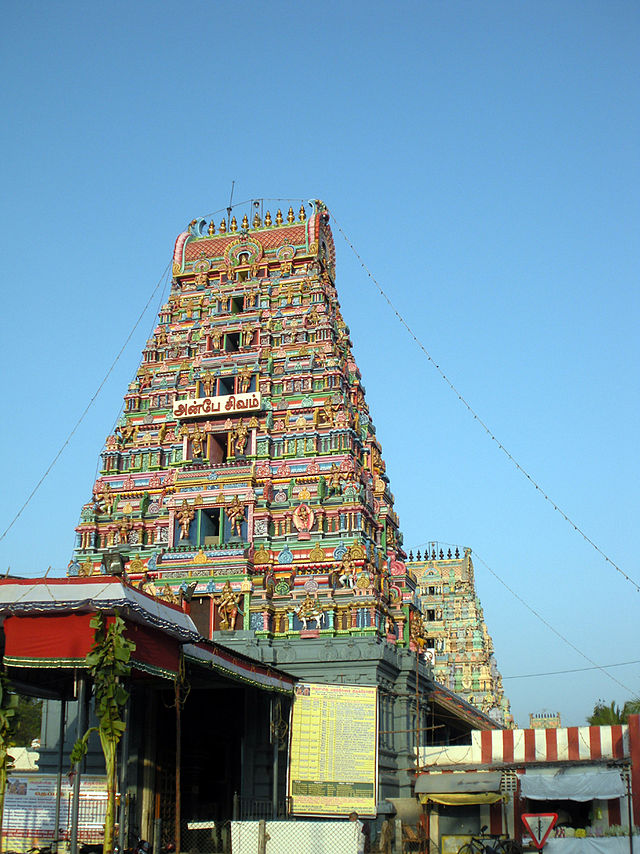Recognizing
the penance of Sage Vasishta on Lord Shiva, Indira sent his Kamadenu the divine
cow with the sage. Once, the cow delayed to pour the milk for puja. The angry sage
cursed it to become an ordinary cow losing its divine status.
He also
suggested the cow to go to this place and worship Lord Shiva under the Vanni
tree to recover its divinity. Kamadenu poured the milk on the Lord and got back
its original supremacy.
Hence,
the Lord has the name Paalvanna Nather. Paal in Tamil means milk. When Sage
Valmiki came there to worship Lord Shiva, Kamadhenu ran in fear pressing its
feet on the head of the Shivalinga, the scar of which is still visible on the
presiding deity.
Lord
Marundeeswarar is known so because he taught sage Agastya about some magical
medicine. Since then the Marundeeswarar temple has been a place of worship for
people with diseases and various problems with their health. It is said that
even The Sage Valmiki, who wrote The Ramayana, came here to The Marundeeswarar
temple to worship The Lord.
Sage
Valmiki was said to be blessed here. After this incident, this place was to be
known as Thiruvalmikiyur, after a long period of time, the name gradually
changed to Thiruvanmiyur. There is a place present in Thiruvanmiyur calledValmiki Nagar in his honour. There is also a temple built for Sage Valmiki in
the middle of the East Coast Road, very close to the Marundeeswarar temple.
The
lingam for which Lord Hanuman performed pooja, The lingam (meenakshi
sundareswarar) that cured the curse of Lord Indra, the Lingam for which Saint
Bharadwaja performed pooja are present here. Markandeyar performed a penance
and prayed to lord Shiva here, Lord Brahma is believed to have conducted a
festival here for lord Shiva. There is a story that Vishnu worshipped Shiva with
his family here to get a son, but he forgot to worship parvati devi who cursed
his son to die at once after birth .Vishnu apologised and she took away the
curse....
Moolavar: Marundeeswarar
Urchavar: Thyagarajar
Amman / Thayar:T iripurasundari
Thala Virutcham: Vanni
Theertham: Pancha Theertham
Agamam / Pooja: Kameekam
Old year:1000-2000 years old
Historical Name: Tiru Vanmikiyur
The temple is praised in the Thevaram
hymns of Saint Tirunavukkarasar and by Arunagiriar. "Lord of
Tiruvanmiyur appears before the devotee praising His endless merciful traits
and removes the illusion in the dull mind.? Saint Tirunavukkarasar. This is the 25th templein Thondai region praised in Thevaram hymns.
Panguni
Brahmmotsavam in March- April,
Shivrathri in February-March,
Vinayaka Chaturti,
Skanda Sashti in October-November, full moon days Kruthika star days.
Lord
Vinayaka is known as Vigneswara. The temple has 5 tier Rajagopuram.
Pongal-pudding is offered as nivedhana to Lord.
The Vimana (tower above the sanctum
sanctorum) of the presiding deity is of Chaturvastam design.
Devotees perform milk abishek to Lord
and consume the Vibuthi (sacred ash) Prasad for cure from prolonged illness and
relief from sins. Circumambulating
the Vanni tree where Lord appeared leads the devotee to salvation. Devotees offer vastras to Lord and
Mother.
Do:
- Do pray your Ishta Devata before pilgrimage to Temple.
- Do contact Temple Devasthanam information centre for enquiry, temple information and for Pooja details etc.
- Do reserve your travel and accommodation at Temple well in advance.
- Do bath and wear clean clothes before you enter the temple.
- Do concentrate on God and Goddess inside the temple.
- Do maintain silence and recite Om Namahsivaya or your Istamantram to yourself inside the temple.
- Do observe ancient custom and traditions while in Temple.
- Do respect religious sentiments at Temple.
- Do deposit your offerings in the hundi only.
Don't s:
- Do not come to Temple for any purpose other than worshipping of God and Goddess.
- Do not smoke at Temple.
- Do not consume alcoholic drinks at Temple.
- Do not eat non-vegetarian food in the Kshetram.
- Do not approach mediators for quick Darshanam. It may cause inconvenient to others.
- Do not carry any weapon inside the temple.
- Do not wear any head guards like helmets, caps, turbans and hats inside the temple premises.
- Do not perform Sastanga Pranama inside the Sanctum Sanctorum.
- Do not take much time while performing Sparsa Darshanam to God in Garbhagriha.
- Do not buy spurious prasadams from street vendors.
- Do not encourage beggars at Temple.
- Do not spit or create nuisance in the premises of the temple.
